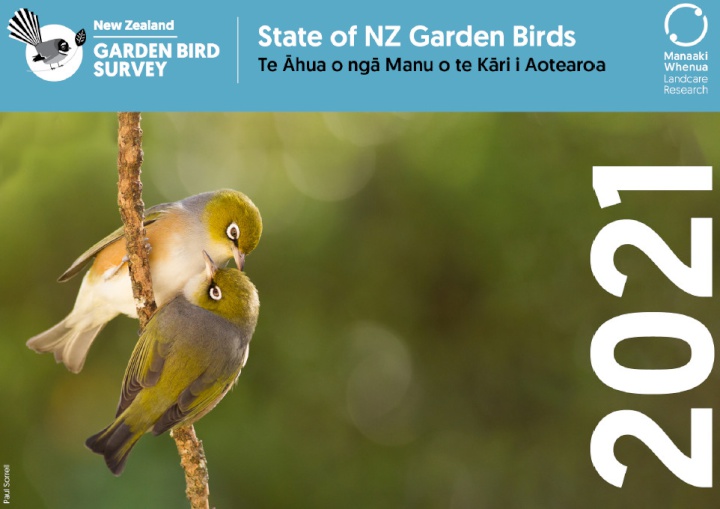Coupled Systems Key To Successful Climate Change Outcomes
TheState of New Zealand Garden Birds 2021|TeāhuaongāmanuotekāriiAotearoa, a report released today by Manaaki Whenua-LandcareResearch, shows the latest results from New Zealand’s longest-running citizen science project – the New Zealand Garden Bird Survey.

Theannual survey, which began 15 years ago and is held every year in July,helpsscientists understand the health of garden bird populations and the wider environment. It does this by showing how bird counts are changing across Aotearoa using two timeframes –over the past5 years andthe past10 years.
In 2021, New Zealanders again turned out in their thousands to take part in the survey and count the numbers of birds they saw in gardens, parks and school grounds - 14,623 people headed outside to complete the survey.
The tens of thousands of garden surveys are put through an analysis using supercomputers. This analysis takes account of whether birds are fed in each garden, whether the garden is in a rural or urban setting, and how many gardens are in each region of New Zealand.
Our data analysis showed positive signals emerging for four native species
- Kererū counts show a 102% increase over 10 years, while pīwakawaka (fantail) counts were up 47% over the same timeframe.
- Tūī (kōkō) continue to increase nationally (30% over 10 years), and increasingly in Canterbury, Marlborough, Otago, and the West Coast.
- And there’s good news for the silvereye (tauhou). The data shows its slow decline is lessening, with a moderate increase in numbers since 2016.
Things are not looking so good for starlings. Numbers continue to decline over both the five and 10 year period, although their rate of decline has slowed compared to last year.
Numbers of song thrush, house sparrows, dunnock, chaffinch, and korimako (bellbirds) show little change over the past five years. There has been little change to myna counts nationally, except in Wellington where they have shown a rapid increase – 202% over the past 10 years.
Manaaki Whenua researcher, Dr Angela Brandt, says the data lets us understand how bird populations are changing across New Zealand. "What's exciting about having so many years of surveys now is that we can see how trends are changing over time. Some species show an uptick - like kererū - or a lessening decline - like tauhou - compared with earlier reports. Importantly, because the survey is done every year, we could have an early warning if a species started to decline."
The NZ Garden Bird Survey founder,DrEric Spurr, says theresults are very encouraging, and show the value of long-term citizenscience monitoring.“Thesurvey does not attempt todetermine thecauses of changes in bird counts,butit is tempting to suggestthatthe increases incounts ofnativebirdsreflect the results of increased predator control and habitat restoration activities around the country.”
This year the survey runs from 25 June – 3 July 2022. There is a lot of bird identification information on the NZ Garden Bird Survey website, so plenty of time to get familiar with the manu that visit your garden. Our post-survey research showed 78% of people who participated in 2020 found the Garden Bird Survey helped their learning about birds and nature.
A full copy of theState of New Zealand Garden Birds | Te āhua o ngā manu o te kāri Aotearoa 2021 can be downloaded here or from gardenbirdsurvey.landcareresearch.co.nz


 Master Plumbers Gasfitters and Drainlayers NZ: 2025 New Zealand Plumbing Conference Awards - Full List Of Winners
Master Plumbers Gasfitters and Drainlayers NZ: 2025 New Zealand Plumbing Conference Awards - Full List Of Winners Insurance Council of New Zealand: Insurers Support Kiwis As Severe Weather Eases
Insurance Council of New Zealand: Insurers Support Kiwis As Severe Weather Eases Science Media Centre: What Goes Into Making Our Seasonal Flu Jab? – Expert Q+A
Science Media Centre: What Goes Into Making Our Seasonal Flu Jab? – Expert Q+A The Document Foundation: Celebrating 20 Years Of The OASIS Open Document Format (ODF) Standard
The Document Foundation: Celebrating 20 Years Of The OASIS Open Document Format (ODF) Standard Maritime Union of New Zealand: Maritime Union Raises Serious Concerns Over Aratere Ferry Removal
Maritime Union of New Zealand: Maritime Union Raises Serious Concerns Over Aratere Ferry Removal Ferry Holdings Limited: Decommissioning Of The Aratere Ferry
Ferry Holdings Limited: Decommissioning Of The Aratere Ferry